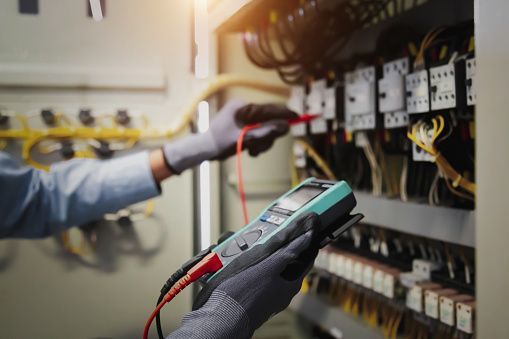How Does a Home Electrical System Work?
Home Electrical System
Electricity is one of the most important things we use in our homes. It operates lights, heating, and cooling and charges those essential cell phones. Understanding how a home’s electrical system works is essential if something goes wrong or if the homeowner wishes to make upgrades. With so many complex and important parts, home electrical work is best left to qualified professionals who understand how to install, repair and maintain electrical equipment safely and effectively.
A home’s electrical system is installed early in the construction process. This keeps wiring and other components safely away from occupants and protects them from damage. Of course, that makes it much more challenging to locate and access wiring if it needs work later on. This is just one more reason why only qualified contractors should work on a home electrical system. Homeowners can quickly do a lot of very expensive damage attempting to locate wiring inside a wall.
Another important part of home wiring has changed dramatically in recent years. The earliest electrified homes had wiring for lights and a few appliances. Today there is much more than that.
The first addition was telephone wiring. While many families have stopped using landlines, nearly all existing homes and even most new construction still features telephone wiring. This is a different type of technology from the electrical system that powers everything in the house. It requires a different skill set for many functions involving installation, troubleshooting, repair, maintenance, and upgrades.
Shortly after that came television wiring. Whether the home was served by an outdoor antenna, a cable company, or satellite dish, the signal was distributed through the house via a coaxial cable installed into wall outlets or, in some cases, wires that were simply stuck through the floor from below. Like telephone cable, TV lines require special skills. If the cable system is not installed correctly, the picture and sound quality can be poor.
Eventually, many homes were equipped with data cables that spread internet access throughout the entire house. Older homes were retrofitted with it, while newer homes were constructed with this new technology incorporated into the plans. Just like phones and televisions, good computer performance relied on the proper installation of data transmission wiring.
Home Electrical Components
The electrical system in a home has many different parts that work together to ensure safe, convenient operation of everything.
Electricity leaves the primary grid through a service line. In many cases, this is an overhead wire that connects to the home, but some homes have underground service. Overhead service lines connect through a weatherhead, the familiar metal pipe that protrudes through the home’s eave.
Next, the power passes through the meter. Most of these now have a digital readout, but some have a spinning wheel inside. The meter measures the amount of electricity being used, and the utility provider uses that reading to calculate the user’s power bill.
One area where many electrical jobs are performed is in the service panel. This is the metal cabinet located in the basement or utility space. Inside are the breakers, each of which should be labeled to tell which part of the house they supply with power. Some homes may have subpanels where additional distribution is done.
There are several types of wiring inside a home. Lighter ones are used for ordinary circuits that operate lights, televisions, and receptacles. A heavier wire is required for significant power users, such as the range, clothes dryer, heating, and cooling system.
There are also several types of receptacles in homes. Dry interior rooms use standard outlets, while kitchens and bathrooms use special receptacles known as ground-fault circuit interrupters ( GFCI’s ). This type has a built-in breaker that cuts power in a short, tripping faster than the breaker back at the panel.
Larger circuits have receptacles as well. Clothes dryers and some ranges have heavy outlets that allow the appliances to be installed and uninstalled more quickly than if they were hard-wired.
Switches come in several types as well. Some are single-pole switches, which work alone to turn something off and one. Three-way switches are installed to operate lights from at least two different switches, such as the top and bottom of a stairwell. Dimmer switches may also be present for adjusting the brightness of a light fixture.
Each type of switch can come in various configurations, including the traditional “flipping” switch and the wide, flat rocker switch. Dimmers can come as a sliding switch or in a knob that can be turned to adjust the lights.
How a Home Electrical System Works
The overhead type of service line will enter the weatherhead then proceed through conduit down to the meter. The underground type comes up through conduit from its buried location, then into the meter.
As soon as the line leaves the meter, it enters the home’s breaker box. This is also known as the service panel or just the service. Inside the breaker box, the electricity is divided among smaller lines that go to other locations in the home. Some may go to a subpanel, which adds more circuits for other functions inside the house.
Each of the smaller lines inside the service panel is equipped with a breaker. This is a particular type of switch that automatically disconnects if something attempts to draw more power through it than it can handle. After the breaker, electricity travels through household wiring into the spaces where it will be used.
Wiring carries the current to the house’s appliances or various electrical boxes. These are either fitted with switches, receptacles, or junctions. Junctions are simply points where the electricity is sent in two or more different directions, eventually ending at a receptacle or switch. That’s where the user plugs something in or turns something on, bringing the system to life.
Mister Sparky Electrician is Tulsa's On-Time Electrician in Broken Arrow, Jenks, Bixby, Sapulpa, and Claremore. Our team of licensed electricians services the Tulsa metro area. In addition to emergency electrical repairs, our residential electrician services include electrical outlet/switch repair, ceiling fan installation, lighting installation, residential wiring repair, landscape lighting installation, and home electrical inspections. Call us today at (918) 205-1309 to schedule an appointment!





